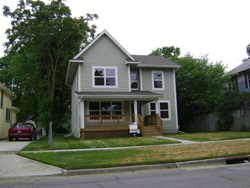AMES, Iowa -- An Iowa State University architecture class is working with the people of Corning to create a prototype house that is both affordable and sustainable. The project is part of a larger collaboration between ISU Extension and local residents to reinvent the small community (pop. 1,700) in southwest Iowa.
Corning is using Neighborhood Stabilization Program funds from the U.S. Department of Housing and Urban Development to purchase several properties. The program provides emergency assistance to particular neighborhoods by acquiring and redeveloping foreclosed properties that might otherwise be abandoned.
One of the Corning properties is designated for the construction of a new house that can be replicated. The money from the sale of the first house will be put into a revolving fund that can be used to build subsequent houses.
Students from ISU's Bridge Studio, a six-credit class for upper-level students in the College of Design, have met twice with residents to develop plans for a house. The class is taught by Nadia Anderson, an assistant professor of architecture and ISU Extension architecture and community design specialist.
The Bridge Studio brings together upper-level students, architects, contractors, government agencies, community organizations and residents of low-income neighborhoods to develop prototypes for affordable, energy-efficient, single-family housing. In 2009, the class garnered two national awards --one for the creative integration of practice and education; and one for excellence in green building education.
"The people of Corning are very motivated to learn how they can reinvent Corning to be a more viable place," Anderson said, referring to the Corning residents. "They're especially interested in seeing how sustainable thinking, building and living can contribute to that."
While Anderson marshals the larger, long-term project with the community, her students are designing a house that eventually can be built on multiple sites and will meet the needs of Corning residents: A 1,000-square-foot, single-story, two bedroom, energy-efficient house that costs $120,000 or less to build.
As part of their preparation, students looked at vernacular (commonplace) building types for design inspiration and for ideas about how houses were built before central air conditioning and heating. Students presented initial designs to residents on Feb. 27, and are sharing their experiences on a blog.
"There was a lot of interest in one of the students' HVAC proposals, which relies on a well-insulated, well-sealed envelope and good solar exposure to eliminate the need for a conventional furnace," Anderson said. "A heat recovery ventilator recovers heat from already-heated air and uses it to heat new, fresh air. This kind of system typically has a back-up resistance heater."
As part of the project, Anderson and her students will conduct research to model and predict the house's energy use. During construction, monitoring equipment will be installed to track actual energy use.
"We want to see if our design decisions are doing what we think they're going to do," she said.
The Corning house is not the first prototype house created and built by students in Anderson's Bridge Studio.

The studio's first project - a house on Forest Avenue in Des Moines - was designed by students in 2008 and built by the Community Housing Development Corporation. The 1,200-square-foot two-story has a simple, compact footprint with an open-concept interior. It's well insulated and well sealed, includes Energy Star appliances and a high- efficiency furnace, and gets good solar gain and natural ventilation. Although new, the house looks like it has always been part of the neighborhood. It's for sale to households with incomes at or below 80 percent of area media income, and listed for $119,000.
Unfortunately, Anderson says, potential buyers for affordable, energy-efficient housing can have trouble finding financing. Mortgage loans rely on real estate valuations that are determined by comparing house size, number of bedrooms, etc. In general, there are no houses comparable to the compact, energy-efficient new houses Anderson and her students design.
Because energy-efficient houses can be slightly more expensive to build, resulting in slightly higher monthly mortgage payments, low-income applicants may not qualify for a loan. However, Anderson maintains that because these houses are less expensive to operate, they actually reduce monthly housing costs, if utility bills are factored in.
"We want to show that by building an energy-efficient house, we reduce utility costs, thereby cutting the overall monthly cost of ownership -- even if the mortgage payment is higher," she said.
"Right now the attitude is that green is too expensive for affordable housing," she said. "Can we create a model that demonstrates that, in fact, this approach is actually a cost saver?"